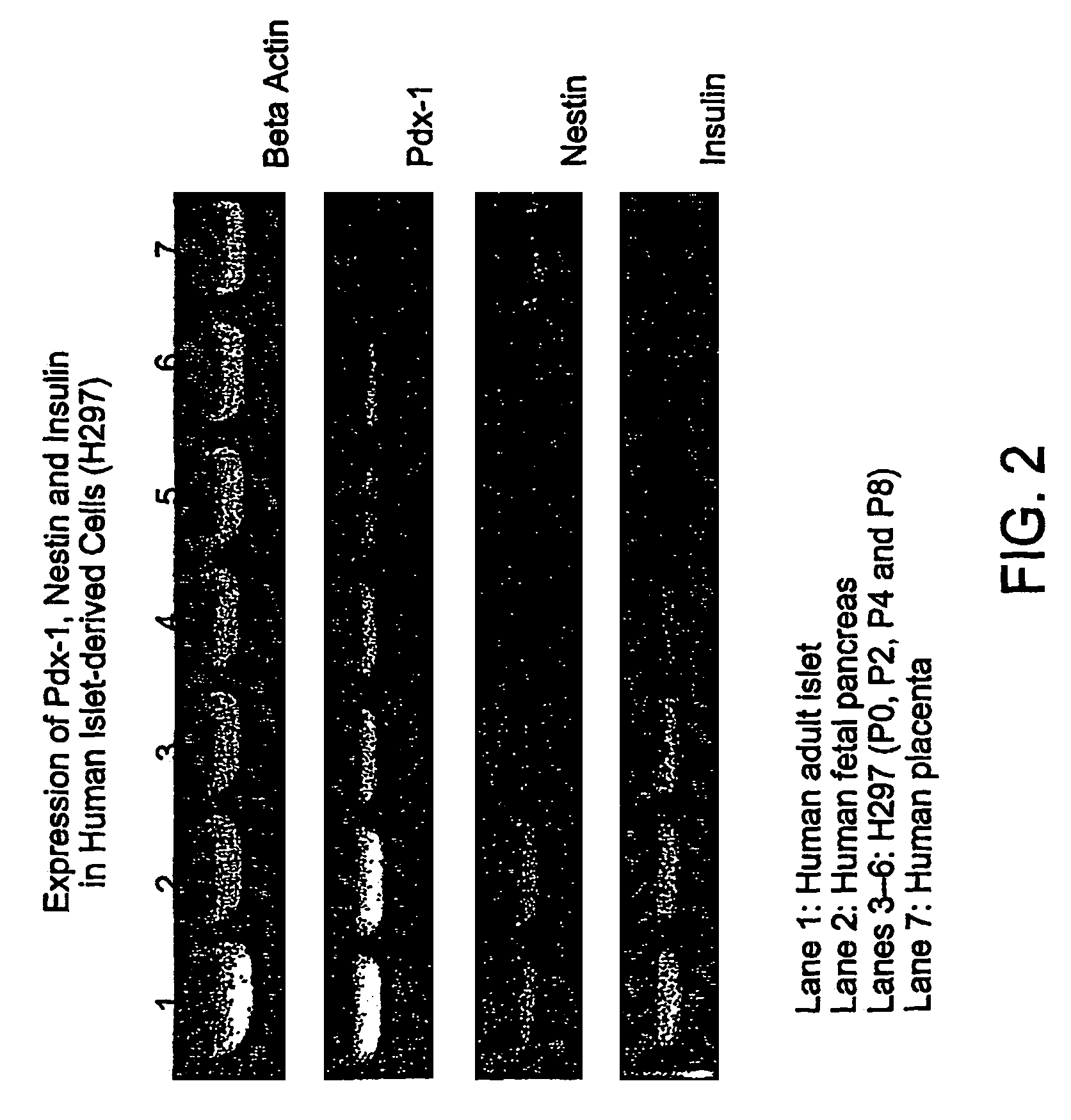Cultured cells from pancreatic islets
a technology of islet cells and pancreatic islets, which is applied in the field of endocrine progenitor/precursor cells of pancreatic islets, can solve the problems of lack of islet cell tissue for transplantation and diabetes mellitus, and achieve the effect of less differentiation
- Summary
- Abstract
- Description
- Claims
- Application Information
AI Technical Summary
Benefits of technology
Problems solved by technology
Method used
Image
Examples
example 1
Isolation of Pancreatic Small Cells from Cadaveric Human Pancreata
[0035]Human pancreatic islet isolation was performed by the semi-automated method originally proposed by Ricordi (Ricordi C, Lacy P E, Finke E H, et al. Automated method for isolation of human pancreatic islets. Diabetes 1988 37:413–420). Procured pancreases were distended by intra-ductal infusion of a Liberase HI (Roche Molecular Biochemicals, Indianapolis, Ind.) or Serva Collagenase (Cresent Chemical, Brooklyn, N.Y.) (linetsky E, Bottno R, Ehmann R, et al. Improved human islet isolation using a new enzyme blend, Liberase. Diabetes 1997 46:1120–1123), and then dissociated using the automated method (Ricordi C, Lacy P E, Finke E H, et. Al. Automated method for isolation of human pancreatic islets. Diabetes 1988 37:413–420). The separation occurs during a process of continuous digestion lasting approximately 12–30 minutes, after which the digestion circuit was cooled and the tissue collected into approximately 8 liters...
example 2
Isolation of Porcine Islet Cells
[0037]Pancreatic islet cells were isolated from a porcine donor and plated using the defined medium to obtain a culture with an epithelial-like phenotyye. The isolation of porcine islet cells procedure is as follows. Two Nalgene containers, several 50 mL round bottom centrifuge tubes, trays, and screens were autoclaved. Two solutions were prepared, UW-D organ preservation solution and three concentrations, 27%, 24.6%, and 11%, of FICOLL solution.
[0038]The UW-D organ preservation solution was made according to the specifications given by Sumimoto et al (Transplantation July 1989; 48(1): 1–5). One liter of 1× UW-D organ preservation solution consisted of 35.83 g of lactobionic acid (Aldrich, Milwaukee, Wis.), 17.83 g raffinose (Sigma, St. Louis, Mo.), 1.23 g MgSO4 (Sigma, St. Louis, Mo.), 0.92 g glutathione (Sigma, St. Louis, Mo.), 0.136 g allopurinol (Sigma, St. Louis, Mo.), and 3.40 g monobasic potassium phosphate (Sigma, St. Louis, Mo.) and double-di...
example 3
[0046]The islets cells acquired by the method of Example 1 were then plated to 60 mm tissue-culture treated culture dishes. The medium used in this example included the following: a base 3:1 mixture of Dulbecco's Modified Eagle's Medium (DMEM) (no glucose, no calcium, with 4 mM L-glutamine) and Hams F-12 medium, and the base is supplemented with the following components with the final concentration of each component indicated: 2 mM L-glutamine (or equivalent), 10 ng / ml epidermal growth factor, 0.4 μg / ml hydrocortisone, 1×10−4 M ethanolamine, 1×10−4 M o-phosphoryl-ethanolamine, 5 μg / ml insulin, 5 μg / ml transferrin, 20 ρM triiodothyronine, 6.78 ng / ml selenium, 24.4 μg / mL adenine, 266.6 μg / mL strontium chloride, 100 mM sodium pyruvate, 10 mM non-essential amino acids, 12.5 mg / mL soybean trypsin inhibitor (SBTI), and 5 mM glucose.
[0047]Human islet cells were cultured from primary cultures derived from the pancreatic tissue as described in Example 1 and passaged to pass...
PUM
| Property | Measurement | Unit |
|---|---|---|
| concentration | aaaaa | aaaaa |
| concentration | aaaaa | aaaaa |
| concentration | aaaaa | aaaaa |
Abstract
Description
Claims
Application Information
 Login to View More
Login to View More - R&D
- Intellectual Property
- Life Sciences
- Materials
- Tech Scout
- Unparalleled Data Quality
- Higher Quality Content
- 60% Fewer Hallucinations
Browse by: Latest US Patents, China's latest patents, Technical Efficacy Thesaurus, Application Domain, Technology Topic, Popular Technical Reports.
© 2025 PatSnap. All rights reserved.Legal|Privacy policy|Modern Slavery Act Transparency Statement|Sitemap|About US| Contact US: help@patsnap.com


